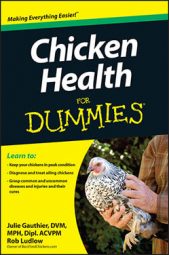For the first few days after hatching, a chick can’t maintain her own body temperature and needs to be kept warm, either by mother hen’s body heat or by a supplemental heat source that you can provide.
The egg yolk, which the chick absorbed into her abdomen during the last few days before hatching, provides an energy source to keep the chick going for a couple of days, while she’s figuring out how to eat and drink.
Hatcheries can ship day-old chicks without food or water because a chick’s absorbed yolk sac provides nutrients for a couple of days after hatching. Chicks get a faster, less risky start on life, however, if you can get them to eat and drink as soon as they’re able.
Newly hatched chicks certainly aren’t completely helpless like some animal babies. Chicks hatch with their eyes open, wearing a birthday suit of cozy down feathers, and are ready to move. However, their digestive tracts, immune systems, skin, and feathers still have a lot of growing to do in the first six weeks of life.
Enjoy your fluffy chicks while you can, because they soon will lose their fluff. The down-covered chick will change her feathers three more times before she grows up. Down is replaced by the first full set of feathers between 1 to 5 weeks of age. A partial molt happens between 7 to 9 weeks old, and an adolescent chicken’s full set of feathers start coming in at about 13 weeks of age.
A growth spurt occurs in the chick between 7 to 12 weeks of age. At the end of that growth spurt, the young bird will be nearly the size of a mature bird and about three-quarters of her eventual grown-up weight.
Several weeks later, the chick’s adolescent pullet sisters are going through a second growth spurt, rapidly filling out their frames and putting on weight in the two weeks leading up to laying their first eggs.

